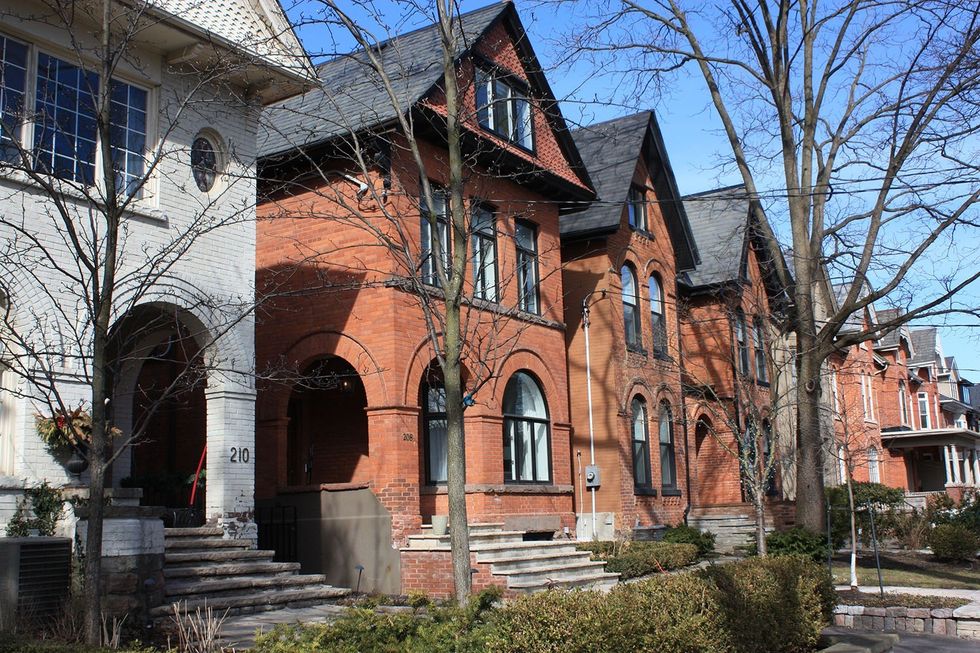
The most indicative part of the Republic of Rathnelly crest is probably the martini glasses.
Each corner of the crest is meant to represent some part of Toronto’s Rathnelly neighbourhood as it was when it declared independence from Canada in 1967. The top right features a rough map of the streets that define the small but vivid corner of Toronto, tucked away north of Avenue and Dupont. The bottom left is the train track

that defines its southern border, a track that defined the early days of the neighbourhood, and almost helped usher in its early end. In the bottom right is a sort of exploded version of the 1967 Canadian centennial logo, signalling the area’s severing of ties with its mother country.
And then there’s the martini glasses. Six of them, in the top right. They signal, well, let’s call it the spirits that led this little pocket of Toronto to declare itself a sovereign nation.
“Everything was a party back then,” explains Pym Buitenhuis, who has the rare distinction of being a second-generation Rathnellian: her parents were among people who first cooked up the plan for secession in the ’60s, when the neighbourhood was faced with becoming an off-ramp of the Spadina Expressway. “Even voting was a party: those were the days when polling stations were in people’s houses, and they wouldn’t have dreamed of casting a ballot without staying for a drink.”
That joie-de-vivre-fuelled-by-eau-de-vie not only helped spark the original idea to secede as a creative way of registering their protest, it buoyed the neighbourhood for years later. “We’re boozing and dancing in the streets,” then-resident Norman Cooper told the Toronto Star during the 1969 Winter Games/Secession Party. “That’s something they don’t allow in Toronto.”
It should be pointed out here that both the antagonism towards Toronto and a good, stiff drink were well-earned. For all the fun and frivolity that became the Republic’s trademark, the secession plot was born of a reasonably serious fight. Toronto lore has it that it was the Spadina Expressway that stirred the neighbourhood to battle stations, but even that was really just the capper in what had been a long fight for the soul of Rathnelly all through the ’60s.
Though it had started as a fairly stately middle-class neighbourhood in the 1880s — central Rathnelly Avenue was named after Sen. William McMaster’s home county in Ireland, and it served as the driveway to his estate before the land was subdivided — by the ’50s and ’60s, Rathnelly had suffered from the hollowing out that greeted many North American cores. Since the Depression, many places had been converted to rooming houses, with city officials considering it ripe for some Ward-esque wrecking and rehabilitation. Besides the Spadina, there were plans to tear down the southeastern corner to make way for a shopping complex, and the briefly considered and often-forgotten Crosstown Expressway was meant to run along its southern edge, near the train tracks. Had all these plans gone through, Rathnelly might look more like Yorkdale Mall than a northern satellite of Yorkville.

The young families that had recently started moving to the area had other ideas, however. Buoyed by the general mood of civic dissent — why yes they did have dealings with Jane Jacobs — the Rathnellians launched a series of creative campaigns to preserve their neighbourhood spirit. Besides the secession, there were public stunts at City Hall and a regular campaign conducted through the press to protest the expressway, as well as official diplomatic relations with Pierre Trudeau to get a playground built.
“These were ad executives, newspaper people, university professors, artists — they knew how to get the word out,” explains Buitenhuis. “They knew that having a bit of fun, having a sense of humour about things, could go a long way.”

They may not have been aware it would go on this long, though. These days, the martini glasses are as likely to be full of chocolate milk — or maybe organic, GMO-free chocolate-flavoured almond milk — as a mixed drink, but the sense of fun still pervades. Neighbours frequent regular committee meetings and the day of their independence is still annually celebrated in June at the park they wrested from Trudeau’s clutches (conveniently located between the power and water supplies for most of midtown Toronto, making the prospect of an intransigent Rathnelly secession a dangerous one indeed). It features everything from the usual barbecue to the naming of a queen to a pitched battle where the neighbourhood kids throw flour bombs at each other.
Besides that last detail being absolutely adorable, it’s also a pretty decent metaphor for the fight that originally brought the neighbourhood together: just because you’re in a fight doesn’t mean you can’t do it with a bit of flowery, er, floury, panache.





















